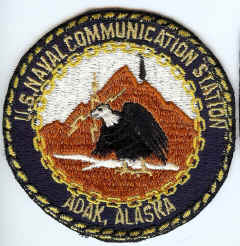
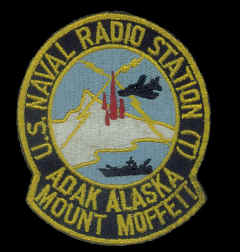
- thanks to Robert Burkhart

- thanks to Robert Burkhart
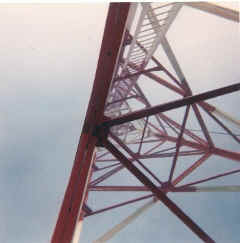
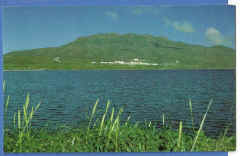
NAVCOMMSTA Adak postcard

NAVCOMMSTA Adak postcard
NAVSECGRU "Shotgun" AN/FRD-10
Lots of interesting photos by Grant Rollins
Also see Naval Radio History of 13th Naval District (Seattle) - 102 MB pdf
Narrative History of NAVCOMMSTA Adak 1942-1959 (from "200 Years Adak AK 1976")
In 1942, the U.S. Navy established a Naval Operating Base on the island of
Adak, .At the same time, communication facilities were set up as an integral part of this base. These facilities consisted of
a Radio Control Station at Heart Lake, where the receivers were located and a transmitting station located at Rocky Point. In September 1943, a Communications Supplementary Activity was established at Clam Lagoon, and a direction finding building was located on Zeto Point. These facilities, housed in
Quonset huts or wooden buildings, maintained the following circuits for the Naval organization on Adak, during and after World War Two: (1)
A multiplex circuit between Adak and Kodiak (2) An international distress circuit (3)
A ship/shore circuit (4) A harbor common circuit (S) An air ground circuit (6) a multipurpose circuit between Adak and
Attu.
The Public Works Authorization Bill, passed by Congress in 1948, provided for the construction of new communications facilities on Adak to replace the temporary, wartime station then in use. Funds for the first increment of construction were appropriated in June 1948. Detailed plans were approved and specific ground sites, close to the old Communications Supplementary Activity, were chosen. In April
1949, permission to begin construction was granted and by the end of the year initial stages of construction were well under way.
The receiver site was located at Clam Lagoon, and the transmitter site was moved farther up the slope of Mt. Moffett, near the old Rocky Point transmitter site. All major buildings were to be constructed of reinforced concrete. The Receiving Station was to have a receiver building, a terminal building, power plant, and facilities for berthing two hundred and fifty men. The Mt. Moffett site was to have a building to house the transmitting equipment, a power plant, and facilities to berth and feed thirty men.
Directed supervision of construction was maintained by an Officer in Charge of construction, and the Officer in Charge, U. S. Naval Communications Supplementary Activity, Adak, was also informed of all details of the planning and construction. Direct logistic support and basic planning of the buildings was provided by the Puget Sound Naval Shipyard, Bremerton, Washington. The Commandant Seventeenth Naval District and Office of the Director Naval Communications were also kept informed of the progress in construction of the Station.
To July 1950, all facilities at the Naval Operating Base Adak were combined into the U.S. Naval Station, Adak, and on 2 October 1951, SECNAV letter, serial 3977P21, established U.S. Naval Communication Station, Adak. The Communication Station was separated from the direct control of the Naval Station and was established as a separate command, although direct logistic support was to be provided by the Naval Station.
The final stages of construction and the installing of electronic equipment continued through the winter of 1951 and the spring of 1952, and on 1 May 1952, the personnel attached to the Communications Supplementary Activity, Adak were transferred to the Naval Communications Station, Adak. On 3 May, 1952, Command Ceremonies were held and Commander (now Captain) Arthur Enderlin, USNR, became the first Commanding Officer of the U.S. Naval Communications Station,
Adak.
The administrative chain of command for NavCommSta, Adak is through the U.S. Naval Station, Adak to Commandant, Seventeenth Naval District. The operational chain of command Passes directly to Commandant, Seventeenth Naval District and then to Director Naval Communications. The District Headquarters is located at Kodiak, 1200 miles to the east of
Adak. NavCommSta, Adak has not participated in any special or joint exercises, other than routine training exercises or defense drills since its establishment.
The Communications Station has received two visits of significance, both occurring in 1959. On 9 May 1959,
Rear Admiral P. Virden, Director of Naval Communications, visited the station, and on 23 July 1959, Admiral J.S. Russell, Vice Chief of Naval Operations, visited the
station. The internal organization of NavCommSta, Adak consists of the Naval Radio Station Receiver (NavRadSta(R)) located at Clam Lagoon, and the Naval Radio Station Transmitters (NavRadSta (T)) located on Mt. Moffett.
NavRadSta (R) has a U.S. Naval Security Group Department, a General Service Division, which operates minor relay, a Public Works Division, and an Administrative Division.
NavCommSta, Adak maintains the following Communications circuits as a part of its operational function: (1) A multiplex circuit to Kodiak, serving all Naval establishments on Adak (2) A multiplex circuit to Honolulu (3) A harbor common net (4) A merchant ship distress circuit
(5) A ship/shore net (6) A Pacific Fleet emergency net (7) A back up for Kodiak fleet broadcast (8) An emergency voice/CW net with the Coast Guard Station
at Attu (9) A circuit with Amchitka and Atka to serve missionaries who are located there (10) A alternate route through which the 1929th AACS Squadron may pass traffic.
1954-55 recollection by LCDR Lee Vernon -
The Communication Station's facilities at Clam Lagoon consisted of the Administrative
Offices, Enlisted Barracks, Post Office, Enlisted Messhall, Bowling Alley and Theater,
Fire Station, Motor Pool and service facilities, Public Works office and shop, and the
water supply consisting of a dammed creek on the side of Mount Adagdak . Further up on the
side of Mount Adagdak was the Operations Building where the General Service Communications
and the Security Group Communications were located.
The other component of the Communications Station was the Transmitter Station at the foot of Mount Moffett. Control of the
transmitters from the Operations Building was by underground cable. The Transmitter Station had a
crew of about 20 enlisted men, a small galley and mess .tall and a small barracks for single
personnel . The antenna field around the transmitter building included rhombic antennas,
one 800 foot vertical radiator for the low frequency transmitter, and a long wire antenna
about a mile long and only 15-20' above ground, also used with the low frequency transmitter. This long wire antenna was strung in an east-west direction and terminated at the
east end to provide directional benefits toward Kodiak . There were no married quarters at
the Transmitter Station and the married personnel lived in quarters at the Naval Station.
The 800' vertical radiator was standing and in use when I arrived, however I believe the
remains of the previous one was still on the ground nearby. The first vertical radiator
was either blown down by winds or collapsed because there was too much tension on the many
guy wires.
The Operations Building at Clam Lagoon housed the General Service Communications that
included a Ship-Shore circuit on 2716 KC , 4235 KC Series, and the point to point circuit
with Kodiak. The largest tenant in the Operations Building was the Security Group. They also used the transmitters
from the Transmitter Station.
All the buildings at Clam Lagoon as well as Mount Moffett were of steel reinforced
concrete construction with steam heat from the central steam plant in the Public Works
building. The Receiver Station at Clam Lagoon had their own power plant. I believe the
same was true of the Transmitter Station on Mount Moffett.
Communication with Kodiak was good most of the time, however there were many times
when sun spot activity, atmospherics, and snow or rain static made it impossible. These
adverse times required the use of the low frequency radio teletype and we were able to
maintain communications when the high frequencies would not go through. The antenna field
around the Operations Building was made up mostly of rhombics plus some verticals around
the building itself .

|

|
||
| Mt. Moffett (circa 1966) - thanks to Robert Burkhart  |
Mt. Moffett (circa 1966) - thanks to Robert Burkhart  |
 NAVCOMMSTA Adak postcard |
 NAVCOMMSTA Adak postcard |
NAVSECGRU "Shotgun" AN/FRD-10 |
-- | NAVCOMMSTA
Adak photo 1972
|
-- |
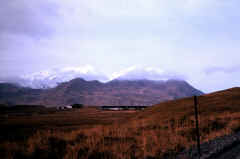 |
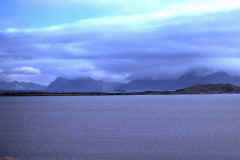 |
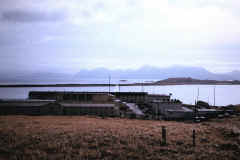 |
 |
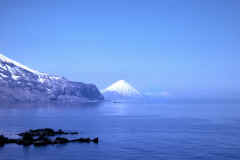 |
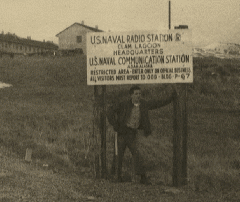 |
Jippy the station dog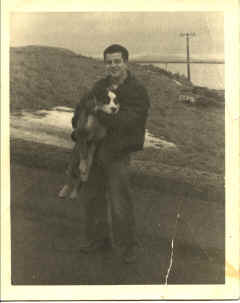 |
-- | - |